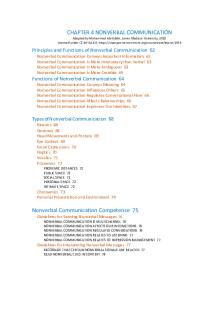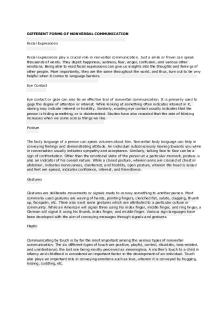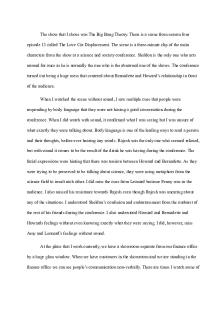Chapter 6 - Nonverbal Communication Issues - Summary Form PDF

| Title | Chapter 6 - Nonverbal Communication Issues - Summary Form |
|---|---|
| Course | Intercultural Communication |
| Institution | Sam Houston State University |
| Pages | 3 |
| File Size | 80.8 KB |
| File Type | |
| Total Downloads | 29 |
| Total Views | 194 |
Summary
Summary of Chapter 6 from "Experiencing Intercultural Communication: an Introduction"...
Description
COMS3370:I nt er cul t ur alCommuni cat i on
Chapter 6 Summary Form 1. What are the major theories and/or topics discussed in the chapter? (2 pt.)
Non-verbal communication The relationship between verbal and non-verbal communication Nonverbal behaviors Cultural differences in nonverbal behavior The role of nonverbal communication in cultural stereotypes. Cultural space Cultural identity and cultural space Changing cultural spaces
2. Who are the representative theorists discussed in the chapter? (1 pt.)
Fran Drescher Edward Hall- “personal space” theorist Steven M. Croucher-communication scholar Kris Acheson-communication scholar who explores the meaning of silence Allan Johnson- a sociologist who explores the non-verbal behavior Bell Hooks-African American writer Malcolm X
3. What are the key claims discussed in the chapter? (6 pts.) In this chapter, the author explains the concepts of nonverbal communication and its relationship with culture. The reading asserts that nonverbal communication can be learned and reinforced with verbal communication. The information is presented in the following sub-topics: the definition of nonverbal communication, cultural variations in non-verbal behavior, and the definition of cultural space. Defining nonverbal communication: The reading defines the practice as a means of communication through ‘physical means’ instead of language. Most of the practice occurs through facial expression, eye contact, and conversational silence. People’s culture significantly influences the non-verbal cues; a concept referred to as cultural space. Therefore, individuals display behaviors associated with their background. The author narrates the case of Iraqi citizens, who are used to shooters. In another example, the chapter explores the experience of an American teacher in Japan. The tutor was impressed with the students’ nodding, thinking that they understood the concepts. However, it turned out that the Japanese learners do not talk in class except when they are asked to contribute to a particular discussion. The teacher was surprised that the students had not understood anything in the lesson. Besides, the author asserts that nonverbal communication can be learned through intercultural interactions. Human beings are social and adapt to new environments. Hence, people should focus on significant issues, such as status and deception, which the nonverbal communicates. Fortunately, learning nonverbal communication is not difficult because some of them are universal. People in multicultural areas
should familiarize with their environment and avoid nonverbal behaviors that can lead them into problems. Cultural variations in non-verbal behavior: Most communities have diverse cultural values which dictate the meaning of nonverbal behaviors. The most common practices include facial expressions that play a significant role in determining a person’s thoughts. The reading claims that people influence each other to use these nonverbal behaviors, a process which results in positive cues. The positive nonverbal behaviors spread across the world as it is being accepted in multicultural environments. A person can learn the meaning of various nonverbal communications by linking them to verbal means. However, the variations in the regulations of the nonverbal communication make it difficult to form universal meanings. The reading asserts that people must associate the context of the behavior before trying to establish its meaning. The nonverbal codes dictate a relationship between individuals. Most issues that define cultural variation include physical appearance, eye contact, silence, facial expression, and personal space. On the other hand, the concept of cultural variation leads to the question of stereotyping. The reading acknowledges that generalization may give a wrong impression about a particular culture. In this case, the chapter gives an example about the perception of silence between Japanese and Americans. The illustration shows that such notions do not apply to everyone. Therefore, cultural variations should not be used as an opportunity for stereotyping other people. Defining cultural space: According to this chapter, cultural space plays a significant role in determining the meanings of various locations. The author asserts that knowing a person’s place of origin gives an insight of his or her culture. Human beings can change their behaviors according to their environment. For example, the author acknowledges that someone from India does not necessarily possess Indians’ non-verbal behavioral codes. The writer says that home is one of the most influential cultural space in the society. People display behaviors that they have been taught in their homes. Nonetheless, the neighborhood contributes to the development of one’s attitudes since persons with similar perceptions dominate it. In Malcolm X autobiography, he asserts that the rules of his family could ‘live’ despite the burning down of their house. The concept was mainly used during the racial discrimination era when some neighborhoods were preserved for whites. At the same time, regionalism is one of the significant cultural space. According to the chapter, some people in the United States still identify themselves with regions, such as Southern and Northern. In this chapter, cyberspace is the last example in the definition of cultural space. In this case, the author say that people meet multicultural individuals and create groups of similar interest and beliefs. Despite the important influence of cultural space in nonverbal codes, one can change the situation through traveling and migration. For instance, female students from the United States are required to change their mode of dressing when they visit Muslim countries. 4. What are some interesting applications of the theories/topics/key claims that are discussed in the chapter? For example, how can the ideas from this chapter be applied to your own life? (3 pts.) The ideas from this chapter are important in identifying and using nonverbal communications. The concept can play a significant role in my life since I interact with people from diverse backgrounds. I need to know the meaning of different nonverbal codes to avoid annoying people.
COMS3370:I nt er c ul t ur alCommuni cat i on
The chapter has taught me that it is not wise to generalize the concept of nonverbal communication among communities since it can lead to stereotyping. Therefore, I plan to learn nonverbal codes of different communities. The practice will help me to discern sincerity by connecting the nonverbal behaviors and verbal communication. I have realized that some people contradict verbal and non-verbal cues. Therefore, it will not be easy to confuse me with the nonverbal behaviors. 5. Think of a pop culture reference to the theories/topics/key claims that are discussed in the chapter. What song, movie, TV shows, etc. can be applied to illustrate the ideas from the chapter? (3 pts.) Chapter 6 explores the essential part of social life which can be applied to various entertainment genres. Nonetheless, the concept reflects a movie known as “A Hundred Streets.” In this movie, the main characters face individual challenges which can only be observed through nonverbal behaviors. For example, Kingsley is a young black American who deals with illegal drugs and participate in armed robberies. His mother is unable to identify his manners until she finds a gun in Kingsley’s room. The audience can feel her pain the moment she found out his son is a criminal. On the other hand, Max displays stressful behaviors following his divorce from Emily. The ex-wife mainly relied on silence as the best means of communicating her new feelings to him. As a result, Max becomes depressed and start taking drugs to relieve his worries. Ultimately, he becomes ‘mad’ and starts shooting in the air due to the perception that Emily has slept with another man. Why are the characters in this movie taking long to identify people’s nonverbal behaviors? Undoubtedly, the question is well answered in this chapter....
Similar Free PDFs

6 - Nonverbal Communication
- 1 Pages

Chapter 4 Nonverbal Communication
- 19 Pages

CH 5 HW: Nonverbal Communication
- 2 Pages
Popular Institutions
- Tinajero National High School - Annex
- Politeknik Caltex Riau
- Yokohama City University
- SGT University
- University of Al-Qadisiyah
- Divine Word College of Vigan
- Techniek College Rotterdam
- Universidade de Santiago
- Universiti Teknologi MARA Cawangan Johor Kampus Pasir Gudang
- Poltekkes Kemenkes Yogyakarta
- Baguio City National High School
- Colegio san marcos
- preparatoria uno
- Centro de Bachillerato Tecnológico Industrial y de Servicios No. 107
- Dalian Maritime University
- Quang Trung Secondary School
- Colegio Tecnológico en Informática
- Corporación Regional de Educación Superior
- Grupo CEDVA
- Dar Al Uloom University
- Centro de Estudios Preuniversitarios de la Universidad Nacional de Ingeniería
- 上智大学
- Aakash International School, Nuna Majara
- San Felipe Neri Catholic School
- Kang Chiao International School - New Taipei City
- Misamis Occidental National High School
- Institución Educativa Escuela Normal Juan Ladrilleros
- Kolehiyo ng Pantukan
- Batanes State College
- Instituto Continental
- Sekolah Menengah Kejuruan Kesehatan Kaltara (Tarakan)
- Colegio de La Inmaculada Concepcion - Cebu












